Blueberry diseases contribute to weakened flowering and reduced yields or no fruit at all. How do you distinguish blueberry diseases so you can respond quickly?
A home remedy for preventing diseases and pests is to water the bushes twice a week with nettle manure.
In home cultivation, blueberry diseases and pests can be treated with natural preparations available in the store:

Blueberry has low soil requirements, but requires constant fertilization. If the plant lacks particular elements, physiological diseases appear:
Fungal diseases are very dangerous for blueberries.
Caused by the fungus Botrytis cinerea, which overwinters in the remains of the plant. Characteristic features are large brown spots on the leaves and gray overgrowth on infected twigs.
A fungus that “overwinters” in the plant. It causes a characteristic white bloom on the leaves and flowers of the plant. Infected flowers die off.
It is caused by the fungus Godronia cassandrae. The rot can be seen on the lower parts of the shoots – the bark cracks there. This disease causes woodiness of the bark, it becomes silvery-grey.
This disease appears in the above-ground parts of the shrubs. The disease symptoms appear when the fruits start to ripen. Anthracnose causes mass rotting of fruit.
A dangerous fungal disease which occurs very rarely. As a result of an infection with this fungus, the fruits dry out before ripening and the shoots turn brown.

White spotting occurs on leaves in the form of small white-gray spots surrounded by a red border. Severely infected leaves die and fall off.
The symptoms of this virus disease are red threads on the shoots and branches. The leaves are small and deformed.
The symptoms of this disease are visible very quickly – leaves and fruits fall off. In subsequent years, the fungus is dormant. The blueberry sprouts new shoots, but the fruit is of poorer quality.
Falling leaves in early summer, on which edge cholestasis appears, can be a symptom of a dangerous fungal disease – scald.
Red, ring-shaped spots appear on the upper side of the leaves.
Soil pests are invisible, feeding mostly on the bark and roots. The most common soil pests are spider mites, wireworms and nematodes – the symptoms of their feeding are difficult to recognize, and the plant becomes more susceptible to disease.
Common pests such as aphids and spider mites can threaten the blueberry, though they are rare. The most dangerous to blueberries are:
>> Read also: Box elder moth. Ways of fighting the pest